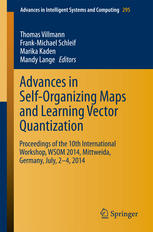

Most ebook files are in PDF format, so you can easily read them using various software such as Foxit Reader or directly on the Google Chrome browser.
Some ebook files are released by publishers in other formats such as .awz, .mobi, .epub, .fb2, etc. You may need to install specific software to read these formats on mobile/PC, such as Calibre.
Please read the tutorial at this link: https://ebookbell.com/faq
We offer FREE conversion to the popular formats you request; however, this may take some time. Therefore, right after payment, please email us, and we will try to provide the service as quickly as possible.
For some exceptional file formats or broken links (if any), please refrain from opening any disputes. Instead, email us first, and we will try to assist within a maximum of 6 hours.
EbookBell Team

4.7
76 reviewsThe book collects the scientific contributions presented at the 10th Workshop on Self-Organizing Maps (WSOM 2014) held at the University of Applied Sciences Mittweida, Mittweida (Germany, Saxony), on July 2–4, 2014. Starting with the first WSOM-workshop 1997 in Helsinki this workshop focuses on newest results in the field of supervised and unsupervised vector quantization like self-organizing maps for data mining and data classification.
This 10th WSOM brought together more than 50 researchers, experts and practitioners in the beautiful small town Mittweida in Saxony (Germany) nearby the mountains Erzgebirge to discuss new developments in the field of unsupervised self-organizing vector quantization systems and learning vector quantization approaches for classification. The book contains the accepted papers of the workshop after a careful review process as well as summaries of the invited talks. Among these book chapters there are excellent examples of the use of self-organizing maps in agriculture, computer science, data visualization, health systems, economics, engineering, social sciences, text and image analysis and time series analysis. Other chapters present the latest theoretical work on self-organizing maps as well as learning vector quantization methods, such as relating those methods to classical statistical decision methods.
All the contribution demonstrate that vector quantization methods cover a large range of application areas including data visualization of high-dimensional complex data, advanced decision making and classification or data clustering and data compression.